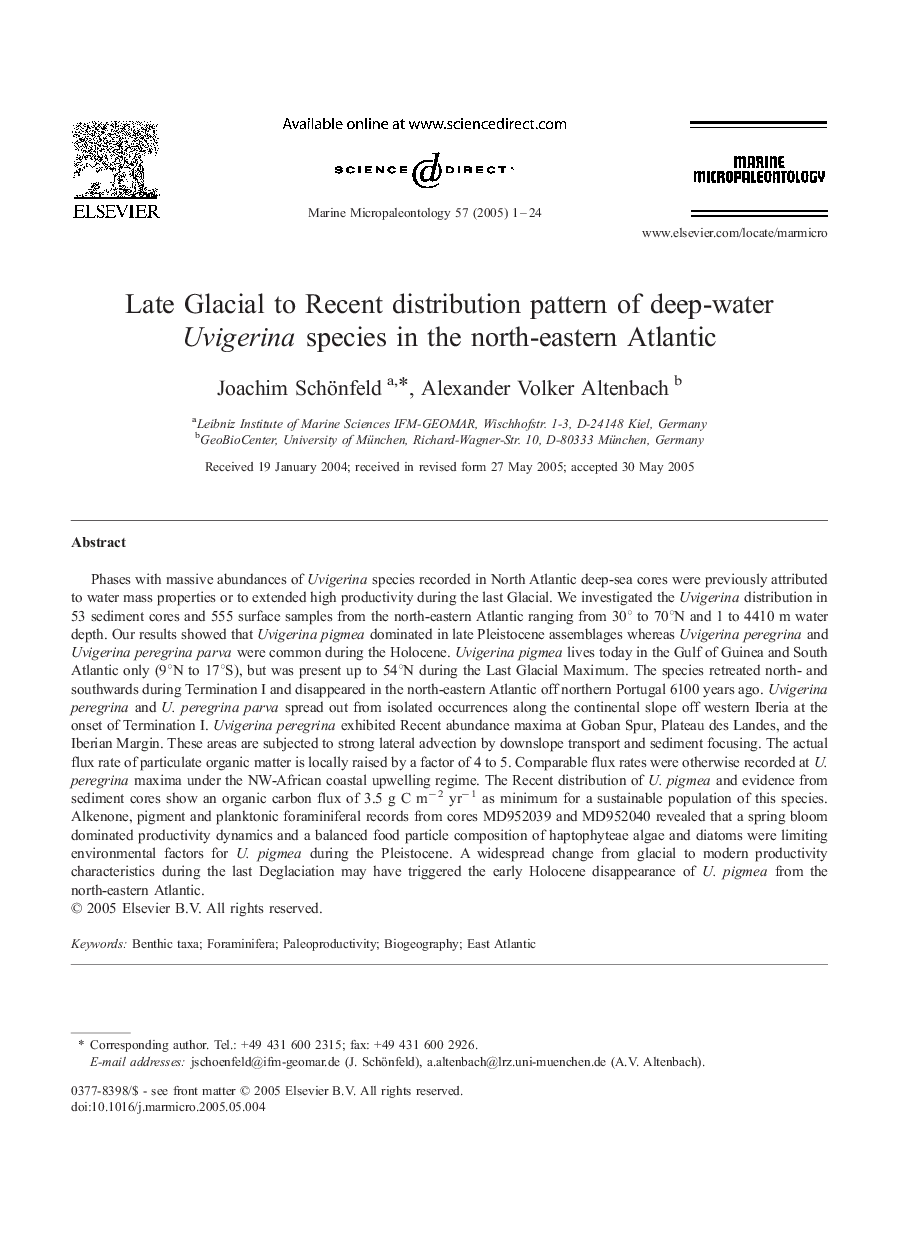| کد مقاله | کد نشریه | سال انتشار | مقاله انگلیسی | نسخه تمام متن |
|---|---|---|---|---|
| 9539560 | 1642235 | 2005 | 24 صفحه PDF | دانلود رایگان |
عنوان انگلیسی مقاله ISI
Late Glacial to Recent distribution pattern of deep-water Uvigerina species in the north-eastern Atlantic
دانلود مقاله + سفارش ترجمه
دانلود مقاله ISI انگلیسی
رایگان برای ایرانیان
کلمات کلیدی
موضوعات مرتبط
مهندسی و علوم پایه
علوم زمین و سیارات
فسیل شناسی
پیش نمایش صفحه اول مقاله

چکیده انگلیسی
Phases with massive abundances of Uvigerina species recorded in North Atlantic deep-sea cores were previously attributed to water mass properties or to extended high productivity during the last Glacial. We investigated the Uvigerina distribution in 53 sediment cores and 555 surface samples from the north-eastern Atlantic ranging from 30° to 70°N and 1 to 4410 m water depth. Our results showed that Uvigerina pigmea dominated in late Pleistocene assemblages whereas Uvigerina peregrina and Uvigerina peregrina parva were common during the Holocene. Uvigerina pigmea lives today in the Gulf of Guinea and South Atlantic only (9°N to 17°S), but was present up to 54°N during the Last Glacial Maximum. The species retreated north- and southwards during Termination I and disappeared in the north-eastern Atlantic off northern Portugal 6100 years ago. Uvigerina peregrina and U. peregrina parva spread out from isolated occurrences along the continental slope off western Iberia at the onset of Termination I. Uvigerina peregrina exhibited Recent abundance maxima at Goban Spur, Plateau des Landes, and the Iberian Margin. These areas are subjected to strong lateral advection by downslope transport and sediment focusing. The actual flux rate of particulate organic matter is locally raised by a factor of 4 to 5. Comparable flux rates were otherwise recorded at U. peregrina maxima under the NW-African coastal upwelling regime. The Recent distribution of U. pigmea and evidence from sediment cores show an organic carbon flux of 3.5 g C mâ 2 yrâ 1 as minimum for a sustainable population of this species. Alkenone, pigment and planktonic foraminiferal records from cores MD952039 and MD952040 revealed that a spring bloom dominated productivity dynamics and a balanced food particle composition of haptophyteae algae and diatoms were limiting environmental factors for U. pigmea during the Pleistocene. A widespread change from glacial to modern productivity characteristics during the last Deglaciation may have triggered the early Holocene disappearance of U. pigmea from the north-eastern Atlantic.
ناشر
Database: Elsevier - ScienceDirect (ساینس دایرکت)
Journal: Marine Micropaleontology - Volume 57, Issues 1â2, September 2005, Pages 1-24
Journal: Marine Micropaleontology - Volume 57, Issues 1â2, September 2005, Pages 1-24
نویسندگان
Joachim Schönfeld, Alexander Volker Altenbach,